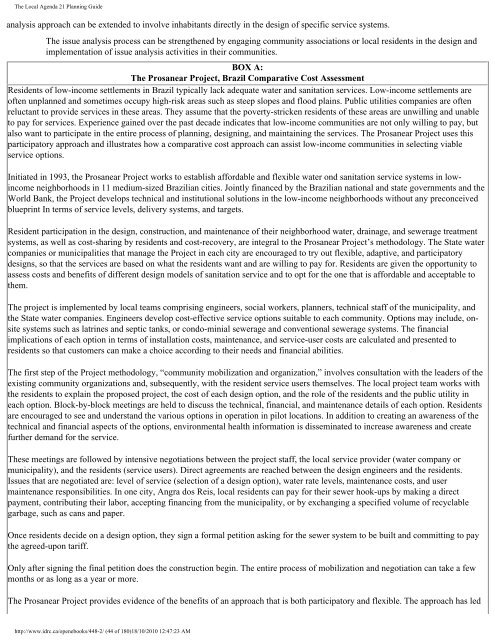The Local Agenda 21 Planning Guide - Democrats Against UN ...
The Local Agenda 21 Planning Guide - Democrats Against UN ...
The Local Agenda 21 Planning Guide - Democrats Against UN ...
Create successful ePaper yourself
Turn your PDF publications into a flip-book with our unique Google optimized e-Paper software.
<strong>The</strong> <strong>Local</strong> <strong>Agenda</strong> <strong>21</strong> <strong>Planning</strong> <strong>Guide</strong><br />
analysis approach can be extended to involve inhabitants directly in the design of specific service systems.<br />
<strong>The</strong> issue analysis process can be strengthened by engaging community associations or local residents in the design and<br />
implementation of issue analysis activities in their communities.<br />
BOX A:<br />
<strong>The</strong> Prosanear Project, Brazil Comparative Cost Assessment<br />
Residents of low-income settlements in Brazil typically lack adequate water and sanitation services. Low-income settlements are<br />
often unplanned and sometimes occupy high-risk areas such as steep slopes and flood plains. Public utilities companies are often<br />
reluctant to provide services in these areas. <strong>The</strong>y assume that the poverty-stricken residents of these areas are unwilling and unable<br />
to pay for services. Experience gained over the past decade indicates that low-income communities are not only willing to pay, but<br />
also want to participate in the entire process of planning, designing, and maintaining the services. <strong>The</strong> Prosanear Project uses this<br />
participatory approach and illustrates how a comparative cost approach can assist low-income communities in selecting viable<br />
service options.<br />
Initiated in 1993, the Prosanear Project works to establish affordable and flexible water ond sanitation service systems in lowincome<br />
neighborhoods in 11 medium-sized Brazilian cities. Jointly financed by the Brazilian national and state governments and the<br />
World Bank, the Project develops technical and institutional solutions in the low-income neighborhoods without any preconceived<br />
blueprint In terms of service levels, delivery systems, and targets.<br />
Resident participation in the design, construction, and maintenance of their neighborhood water, drainage, and sewerage treatment<br />
systems, as well as cost-sharing by residents and cost-recovery, are integral to the Prosanear Project’s methodology. <strong>The</strong> State water<br />
companies or municipalities that manage the Project in each city are encouraged to try out flexible, adaptive, and participatory<br />
designs, so that the services are based on what the residents want and are willing to pay for. Residents are given the opportunity to<br />
assess costs and benefits of different design models of sanitation service and to opt for the one that is affordable and acceptable to<br />
them.<br />
<strong>The</strong> project is implemented by local teams comprising engineers, social workers, planners, technical staff of the municipality, and<br />
the State water companies. Engineers develop cost-effective service options suitable to each community. Options may include, onsite<br />
systems such as latrines and septic tanks, or condo-minial sewerage and conventional sewerage systems. <strong>The</strong> financial<br />
implications of each option in terms of installation costs, maintenance, and service-user costs are calculated and presented to<br />
residents so that customers can make a choice according to their needs and financial abilities.<br />
<strong>The</strong> first step of the Project methodology, “community mobilization and organization,” involves consultation with the leaders of the<br />
existing community organizations and, subsequently, with the resident service users themselves. <strong>The</strong> local project team works with<br />
the residents to explain the proposed project, the cost of each design option, and the role of the residents and the public utility in<br />
each option. Block-by-block meetings are held to discuss the technical, financial, and maintenance details of each option. Residents<br />
are encouraged to see and understand the various options in operation in pilot locations. In addition to creating an awareness of the<br />
technical and financial aspects of the options, environmental health information is disseminated to increase awareness and create<br />
further demand for the service.<br />
<strong>The</strong>se meetings are followed by intensive negotiations between the project staff, the local service provider (water company or<br />
municipality), and the residents (service users). Direct agreements are reached between the design engineers and the residents.<br />
Issues that are negotiated are: level of service (selection of a design option), water rate levels, maintenance costs, and user<br />
maintenance responsibilities. In one city, Angra dos Reis, local residents can pay for their sewer hook-ups by making a direct<br />
payment, contributing their labor, accepting financing from the municipality, or by exchanging a specified volume of recyclable<br />
garbage, such as cans and paper.<br />
Once residents decide on a design option, they sign a formal petition asking for the sewer system to be built and committing to pay<br />
the agreed-upon tariff.<br />
Only after signing the final petition does the construction begin. <strong>The</strong> entire process of mobilization and negotiation can take a few<br />
months or as long as a year or more.<br />
<strong>The</strong> Prosanear Project provides evidence of the benefits of an approach that is both participatory and flexible. <strong>The</strong> approach has led<br />
http://www.idrc.ca/openebooks/448-2/ (44 of 180)18/10/2010 12:47:23 AM










